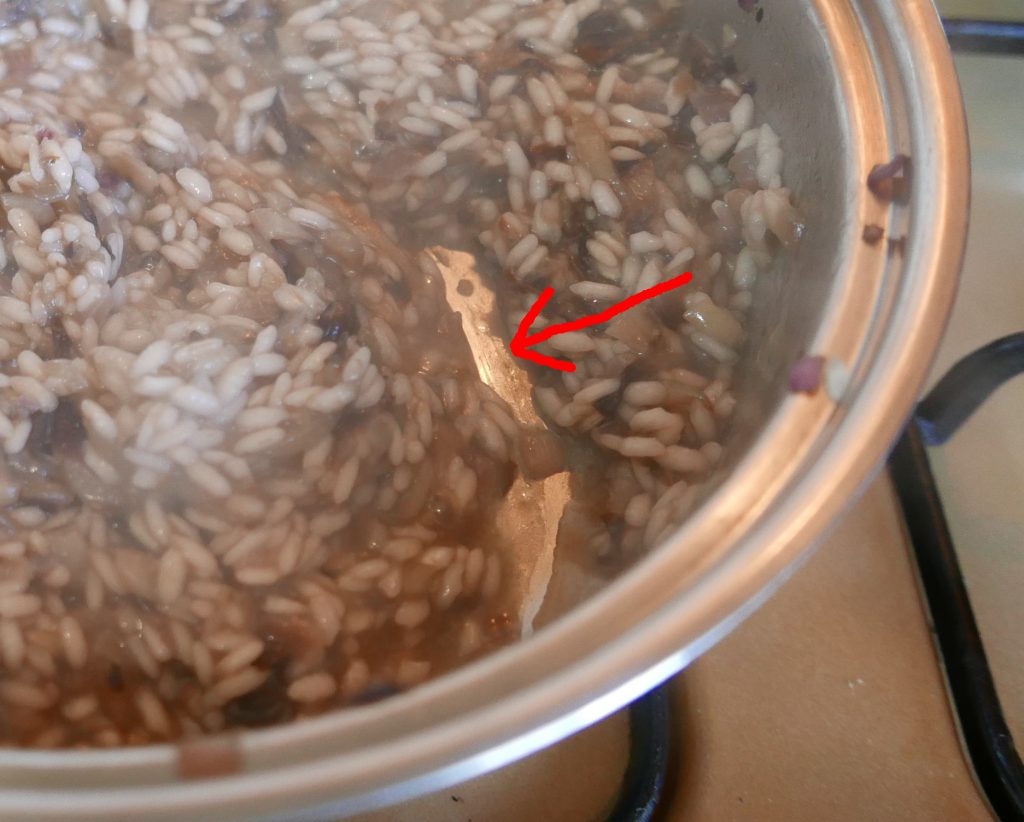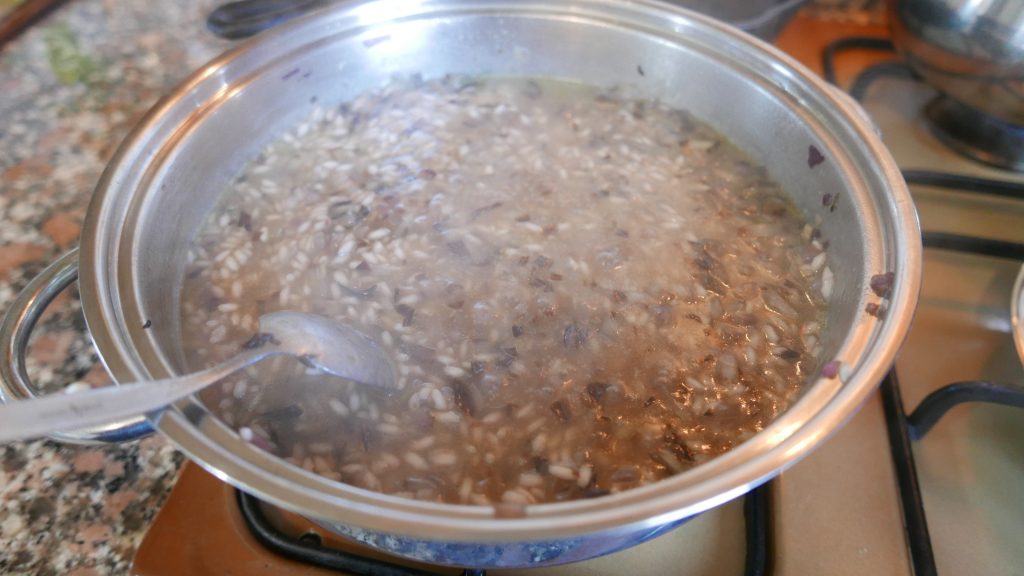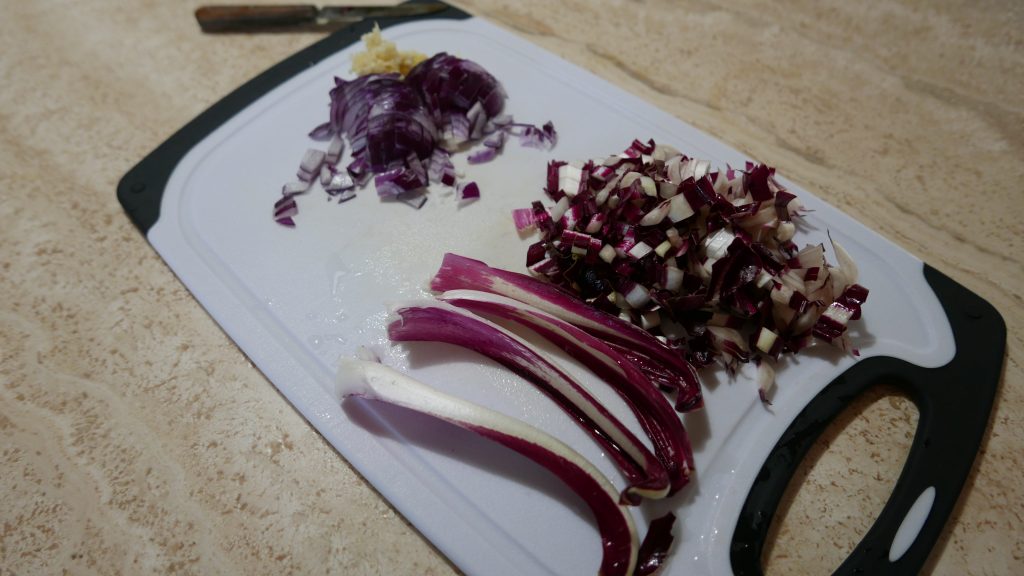Everyone knows how to make risotto right?
I guess. But the risotto I’ve had in Italy is remarkably different than what I had in the US. It’s creamy, for sure, but the rice has more of a bite left. Also, I’ve been introduced to several new and exciting types of risotto!
Risotto alla trevigiana is one of these.
Trevigiana – first – means “of Treviso” (as in, something/one from there). Treviso is a city in the region of Veneto (the same region where Venice is), which is relatively far away from where I live. Seeing as how I’ve learned to make this risotto from a Pavese family, it’s altogether possible that this is completely wrong. Regional cuisine is a big thing here, and people care a lot. (In my first Italian office job, my coworkers — young techies, mostly male, not super foodie types, for Italians anyway — once had a heated argument during lunch about which type of pot or pan is correct for making risotto.)
Anyway, this is how my (Italian) family makes this dish, so, here it is!
This is quite an ugly brown-grey food, but trust me, it’s worth it.
First some tips about making risotto “the right way” (at least, as I’ve learned, every region and family has their own right way).
THE RICE
My partner’s mother always uses carnaroli rice. From my Googling, carnaroli rice is supposed to be easier than other risotto rices. I’ve consistently gotten good results with it, and I’m not an expert, so yay! Definitely recommended if you can find it.
You can also use arborio, ribe, roma, baldo, or a number of more esoteric types of rice. Any Italian short- or medium-grain rice is probably fine, though it may take longer (and more liquid) to cook! Just be patient and keep adding liquid until it’s a nice texture. (I’ve spent nearly two hours with fancy organic brown baldo rice grown about a kilometer from my house.)
If you’re in the US, the easiest risotto rice to find is probably arborio. I do recommend trying out one of these other varieties if you see it! However, if you don’t have anything else available (or don’t want to spend a ridiculous amount on rice), arborio is fine.
My experience with arborio rice is that it goes from crunchy to overcooked very quickly. So be careful to taste very frequently, and stop cooking as quickly as possible when it’s done. Also err on the side of smaller liquid additions, so you won’t have to cook down too much at the end.
WHEN TO ADD LIQUID
As you (probably?) know, when you make risotto, you repeatedly add liquid, cook, add liquid, cook, add liquid, cook….. until you feel like you probably never want to eat risotto again. Anyway, when should you actually add liquid?
When you stir the risotto, the spoon creates a “valley” where you can see the bottom of the pan. Eventually this valley fills in. You should add liquid when the valley holds for about 5 seconds. It looks like this:

Don’t worry too much if you don’t get this exactly right – it’s not all that critical. You’ll get a feel for it after you’ve done it a few times!
And how much liquid to add?
Well…. if you’re lazy, you can get away with adding a lot. However, for optimal texture, only enough to just barely cover the rice in liquid again. If you’re not sure, it’s always safe to err on the side of less liquid.

WHEN IS IT DONE?
When there’s still a bit of a “bite” to the rice, but it’s super creamy and delicious.
Cook it until you like the rice texture, and then cook off the rest of the liquid until it’s creamy.
WHAT EVEN IS TREVIGIANA?
It’s a kind of radicchio that looks vaguely like an octopus, and is much less bitter and slightly sweeter than normal radicchio. You can also find it called “radicchio tardivo,” “radicchio di treviso,” etc. Or possibly something completely random. Anyway, if it’s a radicchio that looks like an octopus, you’re all good.

You can also substitute regular radicchio, but use a bit less, and if it tastes very bitter, add a pinch of sugar.
Risotto alla trevigiana
Ingredients
- 1 clove garlic minced
- 1 onion chopped small
- 2 tbsp olive oil extra virgin
- 1-2 heads radicchio trevigiano or other radicchio, washed, leaves removed sliced
- 1 l vegetable broth (about 4 cups, or one 32 oz container)
- 250 g carnaroli rice (about 1 ¼ cup) or other risotto rice
- salt
- lemon juice to taste, optional
- vegan butter or additional olive oil optional
- vegan parmesan cheese finely grated, optional
Instructions
- Prepare the ingredients – mince the garlic and chop the onion and radicchio.
- Put the vegetable broth in a pot over high heat and bring to a boil. Turn it down to a simmer.
- While the broth is heating, saute the onion and garlic in the olive oil and a pinch of salt over medium-low heat until soft and slightly browned.
- Add the radicchio, and cook for another few minutes until it begins to soften.
- Add the rice, and stir for a few minutes.
- Add some vegetable broth, and begin the risotto process – cook til the liquid is absorbed, add more liquid, repeat until the risotto is done!
- While the risotto is cooking, taste frequently for salt. If it's beginning to get too salty, add water to your broth.
- When the risotto reaches the desired texture, add the optional ingredients (butter, additional oil, lemon juice, cheese), and stir. Cook for a minute or two to melt the cheese and butter. Taste again for salt and acidity, and add more salt or lemon juice if necessary.
Notes
- I normally make this recipe only with lemon juice, and my partner’s mother makes it without any of the optional ingredients. It’s super delicious without them, they are 100% optional!
- This recipe serves 2 as a main course, and up to maybe 4 as a first course. When in doubt, double it (it reheats okay in the microwave).
- You may not use all the broth – that’s okay! Refrigerate and use for something else.
- You may also have to add additional liquid. Use more broth, or just water. If you notice the liquid starting to run low, preemptively add more so that it has time to warm up.
- If you want to use vegan parmesan, I recommend Violife parmesan (the wedge), or make your own from The Gentle Chef‘s Cook & Let Live cookbook.
